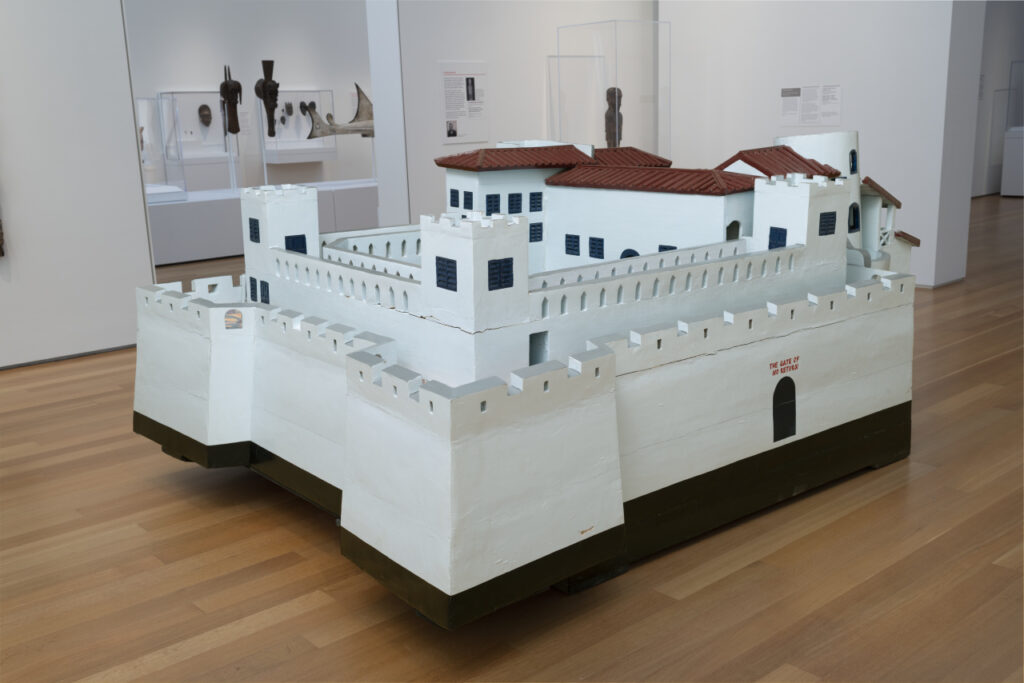Elmina Castle – Elmina (1482 Portugal – 1637 Netherlands – 1872 Britain) (work of art)
Artwork Info
Key Ideas
- This sculpture is a replica of one of the many coastal fortresses in Ghana in which human beings were bought and sold during the transatlantic slave trade. The building this work depicts is located in present-day Elmina, Ghana (formerly the Gold Coast).
- Elmina Castle is an important landmark in Ghana. As a UNESCO World Heritage Site, it is legally protected for its cultural and historical significance.
- Paa Joe is a Ghanaian artist and coffin maker. He is best known for the unique coffins he makes in shapes like paintbrushes, sneakers, airplanes, and different types of animals. His custom-made “fantasy coffins” honor deceased individuals by representing what was important to them in life.
- Paa Joe’s replicas of coastal fortresses represent real places where millions of African people were sold into slavery and sent to the Americas and Caribbean islands by ship.
Learn More
This wooden sculpture is a replica of Elmina Castle. The actual building is a protected landmark and UNESCO World Heritage Site in Elmina, Ghana. Elmina Castle is one of approximately 80 stone fortresses along the Gold Coast (present-day Ghana) in which human beings were trafficked during the transatlantic slave trade. It was part of the global slave trade that began in the 1500s and lasted through the 1800s. The transatlantic slave trade accounts for approximately half of the 12.5 million enslaved Africans who were transported across the Atlantic Ocean.
Joseph Teteh Ashong (known as Paa Joe) is a Ghanaian artist and coffin maker. He collaborates with his son Jacob to create “fantasy coffins.” Their custom-made coffins range in shape from lions, fish, and chickens to paintbrushes, sneakers, and airplanes. The coffins are intended to honor deceased individuals in a creative way. The shape of each coffin symbolizes the person’s character and life accomplishments.
While Paa Joe’s replicas of Elmina Castle and 12 other slave forts are not actual coffins, they reference these physical structures as vessels of death. His architectural models represent the buildings where millions of Africans were sold into slavery and forced onto ships to the Americas and the Caribbean islands. Paa Joe uses traditional techniques and materials to create large-scale wooden sculptures that serve as powerful reminders of where the journey into slavery began.
I had to travel many times to the sites, looking at them carefully before making them. These are pieces that you have to travel afar to watch and come back to make. They are about the identity of humanity. Their lasting message is that we can’t maltreat our fellow humans.
Paa Joe
Over the front door of this sculpture, Paa Joe lists the fortress’s history of colonial ownership (the act of a foreign nation gaining and maintaining political control over another country). His hand-painted text includes the names of the countries that captured and ruled Elmina Castle and the corresponding dates. “The Gate of No Return” is painted in red above the sculpture’s two back doors. After being forced through those doors at Elmina Castle, which opened directly to ships on the sea, enslaved people began a long journey during which many died.
May humanity never again perpetrate such injustice against humanity. We, the living, vow to uphold this.
Excerpt from memorial plaque at entryway of Elmina Castle
Additional Resources
Resources for Teachers
- Read an article about this sculpture and the history of Elmina Castle on the NCMA website.
- Read Paa Joe’s artist bio.
- Watch a video about Conan O’Brien’s visit to Ghana and the fantasy coffin Paa Joe designed for him.
- Explore a website to view lesson plans, articles, and videos about the transatlantic slave trade.
Resources for Students
- Watch a short video about Paa Joe’s fantasy coffins.
- View a fantasy coffin shaped like a Nike sneaker.
- Take a virtual tour of Paa Joe’s Gates of No Return exhibition at the High Museum of Art and see more examples of his work.
- View images of Elmina Castle in present-day Elmina, Ghana.
Images
-

Elmina Castle – Elmina (1482 Portugal – 1637 Netherlands – 1872 Britain)
A large-scale wooden sculpture of a white castle with fortified towers and a reddish-brown roof. It is displayed on the wooden floor of a gallery space, surrounded by other works of art in the background. The base of the sculpture is black and curves upward on each side, resembling the hull form of a ship. “By Paa Joe” is handwritten in black at the bottom right edge of the sculpture.





